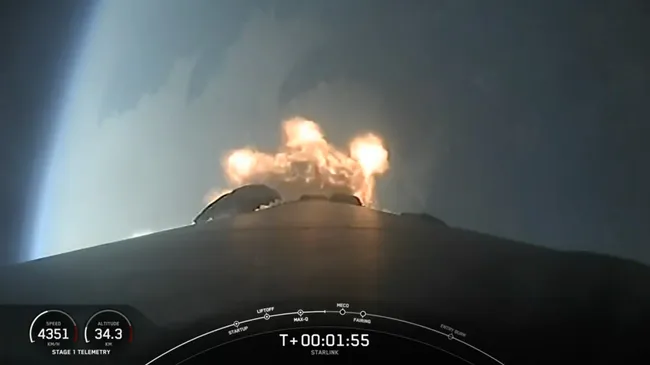
A SpaceX Falcon 9 rocket launches 20 Starlink satellites to orbit from California on July 11, 2024. The second stage failed shortly after this picture was taken. (Image credit: SpaceX)
By Elizabeth Howell,
published by Space.com, 15 July 2024
A Falcon 9 rocket’s second stage failed during a SpaceX Starlink satellite launch on July 11.
NASA is waiting to see if there will be “schedule impacts” for its next astronaut mission aboard SpaceX after a rocket failure last week, the agency said in a recent statement.
SpaceX‘s Falcon 9 rocket had a rare anomaly during a Starlink satellite launch on Thursday (July 11). The second stage on the rocket failed to work as planned, stranding the broadband satellites in an unusual orbit. As SpaceX and the Federal Aviation Administration (FAA) investigate why this occurred, an International Space Station (ISS) mission is under scrutiny.
Falcon 9 is also used to send NASA astronaut missions to the ISS aboard SpaceX’s Crew Dragon spacecraft. The next scheduled effort, known as Crew-9, was supposed to send four astronauts aloft in mid-August. The group will relieve Crew-8, which has been on the ISS since March for what was expected to be about a half-year mission.
“Crew safety and mission assurance are top priorities for NASA,” agency officials said in an e-mailed statement late Friday (July 12), adding they will “provide updates on agency missions including potential schedule impacts, if any, as more information becomes available.” SpaceX, the statement added, has been providing information to NASA as the anomaly investigation proceeds.

ISS missions, which typically last six months at a time, have flexibility built into them if they need to stay longer in space. SpaceX, however, is the only fully certified spacecraft that sends astronauts to space from U.S. soil.
The other crewed option is Boeing’s Starliner, but it’s not yet approved for operational ISS launches. A test mission, known as Crew Flight Test, is onboard ISS right now with two astronauts. Starliner is certified to return to Earth, but only in case of emergency; a complex investigation is ongoing after Starliner had issues with helium leaks and thrusters after its June 6 docking with ISS. The mission was only supposed to last 10 days, but due to the issues, a landing date is not yet scheduled.
See: Original Article





